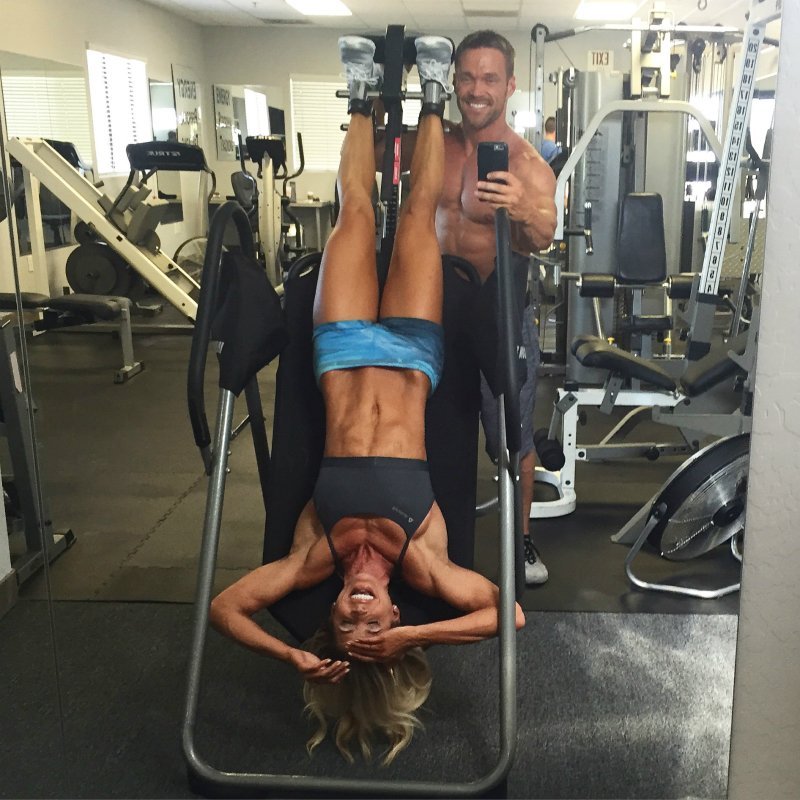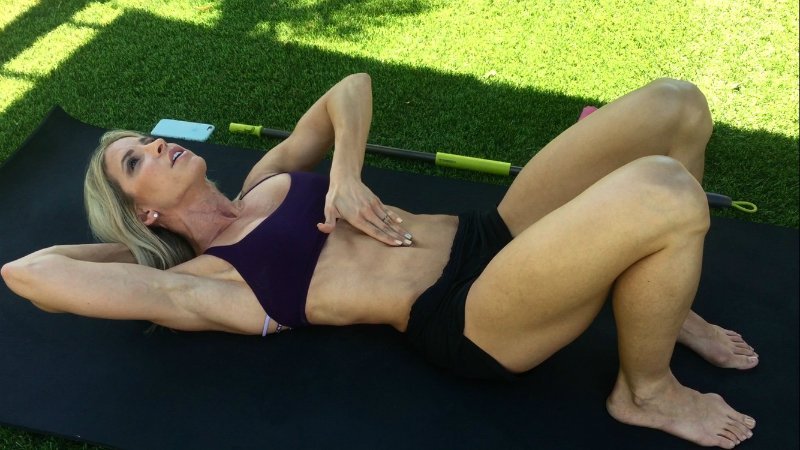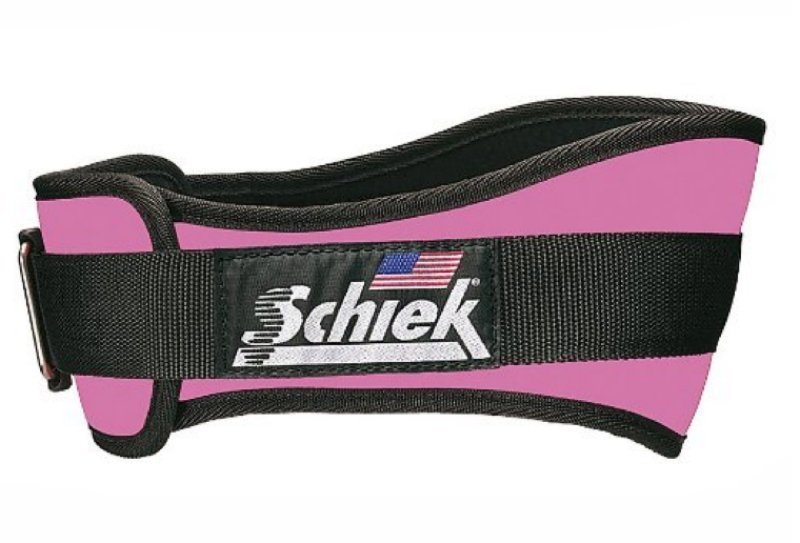Ok, here it is! Girl to girl, we need to discuss something I THINK is more common than I’ve ever believed! I’m getting a little personal and a little science-y on you today to talk about diastasis recti. Diastasis rect-who? Rect-ME! (Ok, stop).
I’m going to warn you up front. There is SO much to cover in this post—it’s a little long. If you wanna’ get straight to the meat (or the exercises you can do to fix your diastasis recti), scroll down. If you wanna’ learn more and figure out if you have this condition, keep reading.
Let me get you up to speed. Diastasis recti generally happens during pregnancy when the two large parallel bands of abdominal muscles separate due to the expanding uterus. Some women’s ab muscles go back to normal after the baby is born, and some do not…mine never have, and chances are yours haven’t either—which is why you are here.
The good news is that the diastasis caused by pregnancy can be corrected with exercises and stretches designed to optimize deep core muscular function. So ladies, don’t worry—your body wants to function right, and it will. We just need to wake up the right core muscles and teach them what to do! But let’s not get ahead of ourselves. Saving that for later.
Now how this happens and why it is worse for some women, no one is 100% sure. But we can hypothesize. It’s been said to be hereditary, but it may also be caused by working out your abs too soon after a baby is born, or even doing the wrong exercises WHILE pregnant. While I didn’t workout during ALL of my pregnancies (just the last 2), I personally feel like working my abs hard during prego worsened my condition. But that’s just my opinion.
Crazy fact, I didn’t even notice my ab separation until after Cash was born!! Yes, 3 kids later. I mean, I knew it was there, but I didn’t realize it was a medical condition. Embarrassingly enough, I always just thought I had definition down the center of my abs! Ha! Nope…wishful thinking. Just diastasis. Once I realized this odd look my midsection had wasn’t normal, nor was it normal for me to be able to literally stick my hand inside of my abs and touch my insides with just skin separating, I knew I had to do something about it. If you’d like a visual, just check out the pic below. This was posted on social media a couple of weeks back, and I got an overwhelming response from women (you!) that suffer from the same condition…
From a medical standpoint, until recently, I had a little over a 3-finger sized gap between my abs that was physically unprotected. Like I said, intestines…right below my skin. And during certain ab exercises, my insides would actually protrude through my abs, forming a weird point. Disgusting, I know. And it’s even scarier to think how vulnerable my vital organs were. If this went untreated, I could suffer from a major intestinal hernia, and given my level of activity (and types of heavy lifting), chances of this happening are higher than most. I mean, I already have an obvious umbilical hernia (my dramatic outtie belly button) so I figure I am more prone than most…
Extensive research on the topic taught me a few things…one of them being there are a handful of factors that make a woman more susceptible to diastasis recti:
- Having more than one child/pregnancy
- Having pregnancies close together
- Being?over the age of 35
- Having big babies
- Having multiple births
I know…some of you are looking at this ist realizing you’ve been double—or even quadruple—whammied! (I?m raising my hand to a couple). Don?t beat yourself up about what you cannot change because diastasis recti is very common—about 67% of all postpartum women have it. So you (and I) are in good company.
If you’re not sure if you are among the lucky few who steered clear of this pregnancy consequence, here’s an easy way to check:
- Lie on your back with your knees bent, soles of your feet close to your booty.
- Place one hand behind your neck and the other hand on your abdomen with your fingertips flat at your belly button, fingers facing downward.
- Gently push your fingertips into your abdomen while rolling your upper body off of the floor, chin towards the ceiling.
- Feel for a separation between those two ab muscles. Experts say that a 2-2.5 finger or more spread signals diastasis recti.
Now, let’s talk about our options moving forward. We can go the immediate and potentially easy (but expensive) route with surgery. BUT, surgery is not always recommended if you are still in your childbearing years…I mean think about it, one more baby, and you’ll pop those abs right back apart! As well, there is no guarantee that surgery will be 100% effective. (SIDE NOTE…Research on this topic started once Chris told me NO to this option because he wants more babies! Another topic for another day…but…).
So for me, at-home exercises and remedies are the way to go. Anytime I can avoid going under the knife, I will. And worst case? If the exercises don’t work, surgery as an option is always going to be there.
Before we go farther—a very important disclaimer: The following “fixes” are all based on my experience and my research, so please check with your doc BEFORE doing anything for your diastasis recti since each case is different. Okay, here goes:
Over this past year, my training protocol has changed as I have transitioned from CrossFit-style workouts to body building. Along with the training change-up, I changed the way I worked my abs too, focusing on decreasing (actually eliminating) the typical ab exercises and increasing the deep-core muscle exercises. I am happy to report that over this year, my abdominal muscle separation has decreased dramatically to less than 2 fingers!! But it still isn’t quite where I need it to be to consider myself healed.
The proof is in the pudding for me: A lot of this boils down to doing the RIGHT exercises. I realize that for so long I was doing what I intuitively thought would work (swing ups, sit ups, V ups, knees to bar, etc), but in reality, these move were working against me by ONLY working my Rectus Abdominus. The REAL muscles that needed working are known as the Transversus Abdominus and Lumbar Multifidus. These are the the most neglected of the ab muscles, but also happen to be arguably the most important. They lie beneath the Rectus Abdominus, supporting posture, controlling breathing during heavy lifts, and supporting the back. These are the muscles elite athletes work to add explosive power to training and are also the muscles we mamas need to work to relieve back pain, create a tighter midsection, AND improve our diastasis recti.
Some at-home exercises you can do to focus on these important muscles are below. I’ve also recorded a demonstration video for you (at the bottom of the post) so you can SEE how to perform these moves right and hear my instructions. Make sure that when you do these moves, you focus and move slowly—keeping the mind body connection. In other words, don’t just go through the moves. You’ll notice that breathing is a KEY component to all of these movements: Deep inhales, and exhale when you activate the muscles.
-
- Drawing In Exercise: Now technically every single move listed below requires you to “draw in,” so I figured I would do a little explaining. Drawing in is NOT sucking in (which uses the outer muscles). Drawing in is done by allowing those inner muscles to pull your abdomen deep inside toward your spine. Draw in from the lower region of your abs. Drawing in is something you can do in sets for as long as you can hold (work up to 60 seconds at a time), or it’s something you can simply do as you walk around your house. Believe it or not, your posture will improve big time with this! This can be done standing, sitting, lying down…you name it. Just DRAW IN!
- Vacuuming: No…not vacuuming your carpet (although I guess technically you can vacuum ON your carpet). I’m talking about the core exercise known by this name. I know I’ve talked about this before, but I’m going to talk about it again. Easily explained, simply stand up straight, inhale deeply, followed by an exhale. Once all of the air is deflated from your lungs, draw your belly button in and up toward your spine. HOLD (as tough as it is) for as long as you can. I aim for 30 seconds, but if holding your breath that long isn’t doable, simply keep the clock running and keep your belly button in and tight as you slowly breathe for the remainder of the 30 seconds. Try for 5-10 reps a day.
- Broomstick Rotations: With a dowel or a broomstick behind your neck, perform a vacuum, then when all air is exhaled and you are holding your breath with your abs squeezed, slowly rotate from side to side until you cannot hold your breath any longer. Breathe. Repeat 5-10 times.
- Abduction with Core Activation: Lie on your back with a resistance band around your knees. Exhale, engage your core and pelvic floor and pull your knees apart. Relax, inhale, and repeat for 10 reps. Be sure to keep your spine neutral and don’t press your lower back into the ground.
- Heel Slide: Lie on your back with both knees bent, feet flat. Exhale as you engage your core and pelvic floor, and slide one heel slowly along the ground until your leg is straight. Inhale and relax, then engage your core, exhale, and draw that heel back. Do 5 reps on each leg.
Once again, scroll to the bottom for my step-by-step video.
Now when it comes to traditional training and weight lifting, consider wearing a weight belt. It has worked WONDERS for me. Not only will a weight belt support your core while lifting heavy loads, but more importantly, it will act as a cue/reminder to activate and draw in with your core while lifting. Otherwise, we are naturally prone to distending our bellies during heavy lifting, only worsening our diastasis recti. This is the one I use…
So ladies, however you choose to take care of your diastasis recti, whether DIY exercises or surgery, know you are making the choice that is right for you! It’s a medical condition and not just a vain aesthetic concern, so if surgery is what you choose, then surgery it is! But if exercises are your method of healing, please keep me up to speed on your progress.
And in the meantime, have those babies, LOVE those babies, and appreciate every consequence of having such perfect little miracles! #BattleWounds
And finally…the demonstration vid…;)
Xoxo,
Heidi
Related reading:
Ask Heidi Anything: Carb Cycling While Prego?
My 1st Post Ruby Workout
My Pregnancy Workout: The Nasty 9s
My 5 Gym (and Home Gym) Must-Haves






262 Responses
Heidi, this is such a great and encouraging post! After having four kids (the last pregnancy was a full-term set of twins), I had DR so bad, and I was so frustrated.
Based on recommendations from a sweet trainer and friend, I did exercises very similar to the ones you suggest here five times a week. After a year and a half (really!), the gap has noticeably gotten smaller and smaller. So stick with it, ladies! You can do it!
A few new DR exercises, thanks!!!!
I have a 3 finger gap and my 3rd “baby” is 6, and I too don’t want to get surgery and am starting to lift a little heavier now and don’t want a hernia due to my gap. Any other ab exercises you recommend to have a variety?
Also, in trying to avoid ab exercises that are counterproductive…besides sit ups and crunches…what others should I avoid?
Example: I like to do side bends, in and outs, pulse ups, mason twists, mountain climbers, planks, bicycles, lay on my back and hold my feet 6 inches off the ground, hanging abs…..any of these make it worse?
For any additional exercises, it would be best to chat with your healthcare team and then follow their recommendations since they know the extent of your DR and can work with you personally. What works for one woman could actually make the condition worse for another, and we certainly don’t want that! We wish you the best!
This is SO. DANG. HELPFUL!! Thank you, Heidi for taking the time to create this post. I’m sure it took so much work but I really, truly needed this. I birthed 5 kids in 7 years, my youngest 3 were born in just 3 years and my core and pelvic floor are shot. The Internet has so much conflicting information regarding this. And it was easy to learn what NOT to do but it felt impossible to figure out how to correct my DR. So I had given up. Thanks a million times!! I’m so excited and starting on these immediately.
I agree – my obgyn never checked me for DR and didn’t mention it during my post-natal appointment. I actually learned about it from my sister in law and did my own research from there. I was lucky in that I was informed from the get go and made sure to do exercises that closed the gap before I moved onto traditional core exercises.
So, I just recently learned from a physical therapist that I have a moderate case of DR. My doctors never mentioned it and my last baby is now 10 years old! I have been doing boot camp and HIIT workouts for the last 4 years and now have a significant lower back injury as well as degenerative disk disease. The pT said it was exacerbated by having the diastasis recti.
My question is after all this time, would it be possible to fix the DR or not? Iamin constant pain now with my back I am unable to do hardly any exercise. I’mso frustrated!
Hi Allie: So sorry to hear about what’s going on! Since we’re not medical professionals, I’d chat with your physical therapist and he/she would be a great resource to help you know what you need to do to help your DR get better and what any possible outcomes may be, and he/she would be a great resource for knowing what could help your back issue also. We wish you the best!
I also found out from my P.T. about having D.R. My OBGYN never mentioned it and my baby is 3.5. I also have a lower back injury. If your P.T. can give you pelvic exercises it will help. In 3 months I’ve closed the bottom gap. Now I’m working on the top.
I’ve seen so many posts regarding exercises you should do, but nothing is ever mentioned on time frame. How long should you do these exercises, or how will I know when I can go back to regular ab exercises?
Hi Tasha: It would be best to consult with your healthcare team about these questions since each case of DR can be very different.
Heidi – how many days a week do you perform all of the exercises?
Hi Christi: I believe Heidi’s does these daily. Or you could do them every other day too.
Hi Heidi,
I have a 3 finger gap on the upper portion of my abs and a 2 finger gap at my belly button. I love the demonstrations and wanted to know if I should do additional moves for the upper portion of my abs or will these exercises help to close it as well?
Thank you!
Whitney
Hi Whitney: These should work for all your abs, but you might want to talk with your healthcare team about what would be best for you since it can be different for each woman and then go from there.
This is great information! Are there any recommendations for pre-partum things we can do to avoid a potential DR issue, or does it help to do the same exercises Heidi already suggested?
Hi Monica: These exercises can work for pre-pregnancy too! For during pregnancy, I’d talk with your healthcare team and then follow their recommendations.
Thank you Heidi, I have 4 children and did not notice my abs separating until after #4, I have always had flat abs after each pregnancy but #4 did me in , my abs are toned but not flat they kind of protrude a little so I look like I am always bloated and I have definite separation. I am excited to try these exercises and see if it helps.
My question is , how do you continue to tone your abs without making the DR worse? You mentioned there are definitely some exercises that make it worse.
Thank you for everything you do !!!! You are an inspiration
Hi Karen: The exercises Heidi shared in this post can be done without making your DR worse, but I’d run them by your healthcare team first and then follow any recommendations they may have. We wish you the best!
I’ve heard sit-ups and front planks can also worsen DR. (Side planks are ok.) basically anything that increases abdominal cavity pressure can worsen it, unless the muscles have been strengthened. That’s why Heidi mentions the weigh belt and exhaling when you lift, because even that action can increase abdominal cavity pressure. I practice exhaling and engaging the inner core muscles (transverse abdominus) when lifting my 2year old. One last note, most doctors don’t have a clue about this. Check with a physical therapist…there are even ones specially trained for these issues.